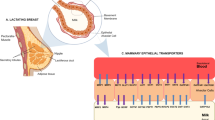Abstract
Mouse urine contains large quantities of proteins (major urinary proteins, MUPs) that are thought to function by binding lipophilic and volatile semiochemicals in a central calyx of the MUP. Two notable semiochemicals are 2-sec-butyl-4,5-dihydrothiazole and a brevicomin (3,4-dehydro-exo-brevicomin). MUPs derived from deposits of urine from wild caught mice contain neither of these ligands, but are replete with menadione. The menadione is probably incorporated in vitro from the environment, although some incorporation in vivo can also be demonstrated. These data show that the calyx of MUPs can bind other hydrophobic molecules derived from the environment, which may influence longevity of signal and deposition patterns of urinary scent marks. The ability to displace, rapidly and completely, the natural ligands by menadione also provides a new tool in the analysis of MUP function.
Similar content being viewed by others
REFERENCES
Abagyan, R. A., and Totrov, M. M. 1994. Biased probability Monte Carlo conformational searches and electrostatic calculations for peptides and proteins. J. Mol. Biol. 235:983–1002.
Abagyan, R. A., Totrov, M. M., and Kuznetsov, D. N. 1994. ICM—a new method for protein modelling and design. Applications to docking and structure prediction from the distorted native conformation. J. Comp. Chem. 15:488–506.
Bacchini, A., Gaetani, E., and Cavaggioni, A. 1992. Pheromone binding proteins of the mouse Mus musculus. Experientia 48:419–421.
Bocskei, Z., Groom, C. R., Flower, D. R., Wright, C. E., Phillips, S. E. V., Cavaggioni, A., Findlay, J. B. C., and North, A. C. T. 1992. Ligand binding of two rodent pheromone transport proteins revealed by X-ray crystallography. Nature 360:186–188.
Borghoff, S. J., Miller, A. B., Bowen, J. P., and Sweenberg, J. A. 1991. Characteristics of chemical binding to alpha 2u-globulin in vitro—evaluating structure—activity relationships. Toxicol. App. Pharmacol. 107:228–238.
Connolly, M. L. 1993. The molecular surface package. J. Mol. Graphics 11:139–141.
Finlayson, J. S., Asofsky, R., Potter, M., and Runner, C. C. 1965. Major urinary protein complex of mice: Origin. Science 149:981–982.
Flower, D. R. 1996. The lipocalin protein family: structure and function. Biochem. J. 318:1–14.
Gosling, L. M., and McKay, H. V. 1990. Competitor assessment by scent-matching: An experimental test. Behav. Ecol. Sociobiol. 26:415–420.
Hastie, N. D., and Held, W. A. 1978. Analysis of mRNA populations by cDNA-mRNA hybrid mediated inhibition of cell free protein synthesis. Proc. Natl. Acad. Sci. U.S.A. 75:414–417.
Hurst, J. L. 1987. The functions of urine marking in a free-living population of house mice, Mus domesticus Rutty. Anim. Behav. 35:1433–1442.
Hurst, J. L. 1993. The priming effects of urine substrate marks on interactions between male house mice, Mus musculus domesticus Schwarz & Schwarz. Anim. Behav. 45:55–81.
Hurst, J. L., Robertson, D. H. L., Tolladay, U., and Beynon, R. J. 1998. Proteins in urine scent marks of male house mice extend the longevity of olfactory signals. Anim. Behav. 55:1289–1297.
Knopf, J. L., Gallagher, J. A., and Held, W. A. 1983. Differential multihormonal regulation of the mouse major urinary protein gene family in the liver. Mol. Cell Biol. 3:2232–2241.
Lehman-Keeman, L. D., and Caudhill, D. 1992. Alpha-2u-globulin is the only member of the lipocalin protein superfamily that binds to hyaline droplet inducing agents. Toxicol. Appl. Pharmacol. 116:170–176.
Laemmli, U. K. 1970. Cleavage of structural proteins during the assembly of the head of bacteriophage T4. Nature 227:680.
Novotny, M., Harvey, S., Jemiolo, B., and Alberts, J. 1985. Synthetic pheromones that promote inter-male aggression in mice. Proc. Natl. Acad. Sci. U.S.A. 82:2059–2061.
Pes, D., Robertson, D. H. L., Hurst, J. L., and Beynon, R. J. 1998. Molecular heterogeneity of MUPs from wild mouse populations, in R. Johnston (ed.). Chemical Signals in Vertebrates. Plenum Press, New York. In press.
Robertson, D. H. L., Beynon, R. J., and Evershed, R. P. 1993. Extraction, characterization, and binding analysis of two pheromonally active ligands associated with major urinary protein of house mouse (Mus musculus). J. Chem. Ecol. 19:1405–1416.
Robertson, D. H. L., Cox, K. A., Gaskell, S. J., Evershed, R. P., and Beynon, R. J. 1996. Molecular heterogeneity in the major urinary proteins of the house mouse Mus musculus. Biochem. J. 316:265–272.
Robertson, D. H. L., Hurst, J. L., Bolgar, M. S., Gaskell, S. J., and Beynon, R. J. 1997. Molecular heterogeneity of urinary proteins in wild house mice populations. Rapid Commun. Mass Spectrom. 11:786–790.
Wallace, A. C., Laskowski, R. A., and Thornton, M. M. 1995. A program to generate schematic diagrams of protein: ligand interactions. Protein Eng. 2:127–134.
Author information
Authors and Affiliations
Rights and permissions
About this article
Cite this article
Robertson, D., Hurst, J., Hubbard, S. et al. Ligands of Urinary Lipocalins from the Mouse: Uptake of Environmentally Derived Chemicals. J Chem Ecol 24, 1127–1140 (1998). https://doi.org/10.1023/A:1022434300449
Issue Date:
DOI: https://doi.org/10.1023/A:1022434300449




